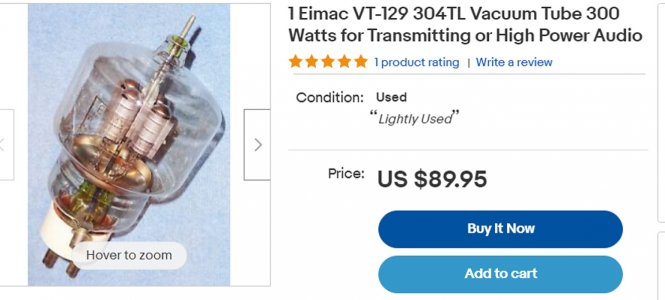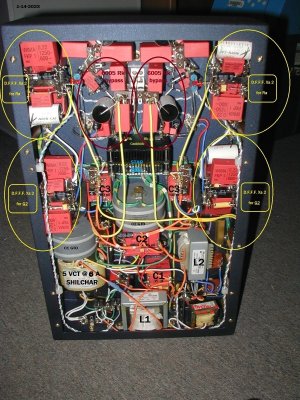PSUDING - NOT Bread-Boarding - the new 6005 TRIPLE CIRCUIT
I have intently spent the last two days at my desk, doing many PSUD power supply iterations, to design the new DC TRIPLE 6005 as I wanted it to be. PSUD software is good enough so as to eliminate the need to bread board the Directly Coupled amp, and I can proceed with all my designing without soldered resistor substitutions to obtain desired voltages.
In a DC amp, all the tube's operation points are related to all the other tubes in the circuit, and if you change ONE resistor value, to some degree,
everything in the circuit's operation changes !!!!
How to design a DC amplifier circuit?
Well, you start with defining precisely how you want
the first tube, the Input / Driver tube to operate, in terms of it's plate voltage, and current draw. One uses tube graphs to determine an
ideal operating point. This is a critical decision. In a two-tube Direct Coupled circuit, the Input tube has the highest gain, often by several fold, thus ALL aspects of its operation are critical - to the amp's overall performance.
An
example of a Driver's tube operating point might be expressed as
“ 10 mA. of current draw with 180 VDC on the tube's plate, at idle ”.
Next, we address the Output tubes ( aka
Finals Tubes) circuit operating points, so many Milliamperes ( current ) at some target voltage. Output / Finals tube operating
voltages are typically expressed as “
Plate of the tube -
to the
Cathode of the tube”. Or as,
Plate to Cathode Voltage “ across ” the tube, or simply denoted
P-K .
An example of a Output / Finals tube operating point ( 6005 ) might be : “30 mA. at 225 VDC P-K .”
From accessible published tube graphs, we may interpret that the Finals tube requires -15 VDC of “ tube bias ” at this desired Operating Point. This is simple now !!
The 6005 will have a VDC of 180 on the control grid ( the Driver tube's desired plate @ 180 VDC ) and it will require 15 volts more, or
195 VDC , to be sought on the
Final's Cathode, to obtain -15 VDC of self-bias at the control grid ( G1 ) .
Realize, this is a TRIPLE 6005, so we are dealing with 30 mA. times three, or 90 mA. TOTAL output tube stage current draw.
Use Ohm's law : 195 VDC divided by 0.090 A. provides us with a triple 6005 Cathode Resistor Value of 2,166.66 Ohms. Select a “standard” power resistor value of 2,200 Ohms,
close enough, ...... only about a 1.5% difference. Rk = 2.2K.
The entire DC amp “
rests ” upon this Final's Rk resistor. It dissipates ( Ohms Law ) 0.090 A. times 195 VDC or
17.55 Watts !!!!! , continuously. I use
four times over rated resistors, so a 100 Watt Rated ARCOL HS ( a
pulse-designed wirewound chassis Power Resistor ) will be an smart, reliable choice. It sounds good BTW !!
What do we want to “ see ” as the 6005's PLATE VDC ?? We know this has to be 195 VDC ( Ek ) plus 225 VDC ( P-K ) , or
420 VDC on the plates ( Ea ) . Another precise VDC design goal, nailed down.

Ea = 420.
We are close to defining it all. What about the Input/Driver tube's Plate and Cathode Resistor values.??
As a rule of thumb, twice the plate's voltage ( 180 VDC ) should be the B+ voltage that feeds the Input Tube. 180 VDC times two is
360 VDC B+, feeding the Input stage.
We can refine the Input tubes 360 VDC value, to FIT
existing standard Plate Resistor values ? For sonic reasons, I may choose doubled-up and matched to 0.1% Roederstein Resista MK-8 resistors, available from Michael Percy. Ohms Law, 180 VDC drop at 10m mA. is 18K , the value for “Ra” of the Input tube. But two in parallel, requires use of a 36 K Ohm pair. What ohmic value is available, in 2 Watt MK-8s ???
Percy carries a 38.3K MK-8 Roederstein Resista Resistor. Closest value. At 10 mA. of driver tube current, two 38.3Ks become a 19.15K ( Ra ). It would drop 191.5 VDC across said paralleled resistor combo. This means we simply re-adjust our precise B+ goal ( to feed the front end ), from 180 VDC Xs two or
360 VDC to
180 VDC plus 191.15 VDC , or to :
371.5 VDC sought as a PRECISE B+ , to feed the Input / Driver tube.
For the driver tube's cathode resistor, use Ohms' law, and select the highest quality resistor you can afford,
and that you have personally evaluated sonically ( eg : Caddock TF-020, etc etc. )
The 6005 is a beam power tube, hence it has a separate G2 connection, which I might run at, say, 5 VDC less than the 6005's operating
plate voltage. That is simple to define : from prior 420 VDC ( Ea ) minus 5 VDC is G2 VDC equals 415 VDC .
- - - - - - - - - - - - - - - - - - - - - - - - - - - - - - - - – - - - - - - - - - - - - - -
So, in all the above, I have shown DIY HFV FMs how to design your own Directly Coupled tube amp. It is my absolute favorite amplifier circuit topology.
I spent the past two days at my desk, with PSUD, experimentally adjusting the filtering which me and my mentor might use ( double shunting and Double Dennis Fraker Final Filtering ) to get the precise voltages I would need to have, for an ideal VDC operation. I often employ the three Manufacturer's R types, as mentioned in this write up. They are some of our sonic favorites, that I depend upon to provide natural-sounding high fidelity sonics.
After a (
common to the entire amp ) dual 5U4GB - L1/C1/L2/C2 input filter, with two 6 ohm DCR chokes ( wow-wee, 12 ohms total DCR !! ) two different sets of
PSUD filter designs need to be developed.
Four filter stages go to the ultra sensitive
Driver tube's Ra,
and four are used for the Finals tubes' ultra sensitive
G2 B+ supply.
As of last night, both my final PSUD chosen B+ "quad filter " choices made me happy. I will wait a few days, and review the work all-over again, to be sure there were no errors.
I will name this amp “ The Dennis Triple – FSHS ”. He is encouraging me to build it. It has design aspects similar to what
impressed Dennis immensely at a Los Angeles audio show, many years ago. It was a tiny 417A, DCed into a Eimac TL-304 four-75 Watt per section ( 300 Watt ) transmitting tube, using four 5U4GB rectifiers. Single ended. A one-time design and execution back then, by the highly-capable Mr. Craig Uthus.
Please notice, how the Eimac 304TL and the 6AQ5/6005 tubes each have symmetrically shaped ROUND plates !!

Jeff Medwin
PS, Voltages mentioned herein serve only as
examples, and are NOT necessarily actual VDCs employed.





